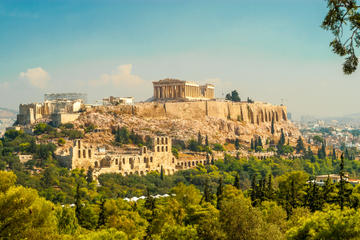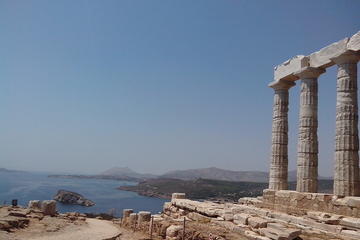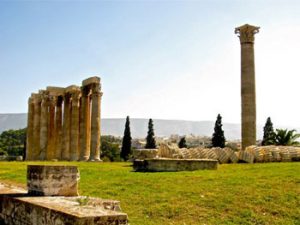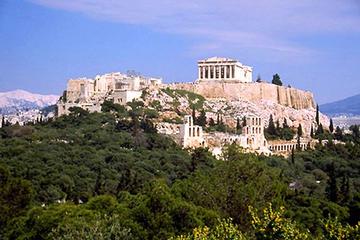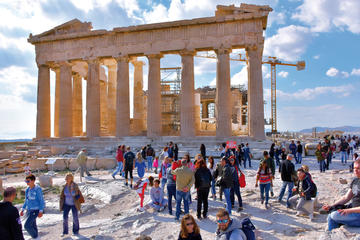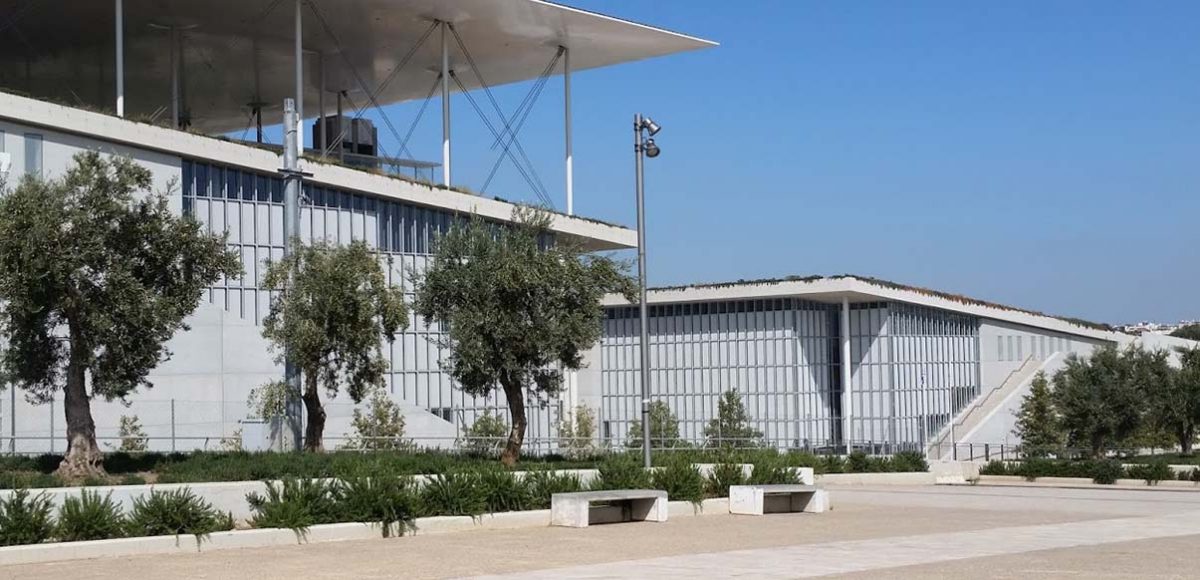
by W. Ruth Kozak
If you are visiting Athens, Greece and want a change from the bustling areas of Plaka and Monastiraki or browsing archaeological sites, hop a trolley or bus and head out to the coast to spend a relaxing afternoon at the stunning new Stavros Niarchos Cultural Center.
Designed by architect Renzo Piano and funded by the Stavros Niarchos Foundation, the €566 million project, completed in 2016, was donated to the Greek state in 2017. The Center includes the Greek National Library, the National Opera House, and an expansive park, built on the former site of an old racetrack.
Stavros Niarchos was a multi-billionaire Greek shipping tycoon who was also noted as a thoroughbred horse breeder. When he died in 1996 in Zurich, his fortune was estimated to be worth in excess of $22 billion. Half was left to a charitable trust to be established in his name, and it was from this trust that the Stavros Niarchos Center was built for the enjoyment of the people of Athens.
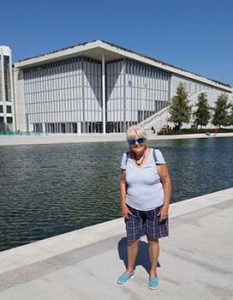 My friend and I spent a pleasant day at the Center exploring the many amenities, enjoying the lovely views from the rooftop garden/restaurant and browsing the gardens.
My friend and I spent a pleasant day at the Center exploring the many amenities, enjoying the lovely views from the rooftop garden/restaurant and browsing the gardens.
We took the tram from Athens and walked to the main entrance across a bridgeway. A canal runs beside the centre where small sailboats drift lazily and kayakers paddle along its length. The 400 meter sea-water canal creates a refreshing place where people can relax or learn to sail and kayak. At night it’s a venue for live jazz and sometimes tango classes.
The architect used rubble to create a slope that doubles as a green roof for the Greek National Library and Opera House. At the top of the roof is a glass observatory with a solar canopy that powers the building below. The building covers nearly 24,000 sq m (235-000 sq ft) and combines traditional with technological innovation.
The Greek National Opera launched its new era at the Center last year premiering its first production with Richard Strauss’ one act opera Elektra. The new facilities provide state-of-the-art acoustics and consist of two auditoriums, a large Main Stage (1400 seats) which hosts operas, concert and ballet and a smaller Alternative Stage (450 seats) that will be used for stage productions, in particular musical theater.
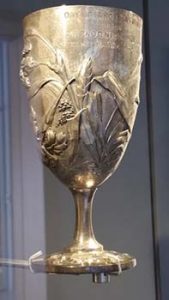 At the entrance of the main building there is a display of photos and exhibits from Greece’s first modern Olympics, held in 1896, when Spyros Louis, a 21-year old water-carrier from Marousi won the first marathon run in modern times. The marathon is now held yearly in remembrance of the first runner in 490 BC who ran from Marathon to Athens to announce the Greek’s victory over the invading Persian fleet. The silver goblet presented to Louis is among the displays. The goblet, financed by French philhellene Michael Brael, is adorned with birds and aquatic plants, a reminder of those that once flourished in the Marathon marshland. The cup was purchased from the Louis’ family heirs in 2012 by the Spyros Niarchos Foundation for €600,000.
At the entrance of the main building there is a display of photos and exhibits from Greece’s first modern Olympics, held in 1896, when Spyros Louis, a 21-year old water-carrier from Marousi won the first marathon run in modern times. The marathon is now held yearly in remembrance of the first runner in 490 BC who ran from Marathon to Athens to announce the Greek’s victory over the invading Persian fleet. The silver goblet presented to Louis is among the displays. The goblet, financed by French philhellene Michael Brael, is adorned with birds and aquatic plants, a reminder of those that once flourished in the Marathon marshland. The cup was purchased from the Louis’ family heirs in 2012 by the Spyros Niarchos Foundation for €600,000.
Upon entering the Center there are a number of open areas to explore including a coffee shop, lounge areas with comfortable settees and chairs and a large computer room as well as a vast library. The area creates a hospitable environment so it’s a good place for relaxing and enjoying the amenities.
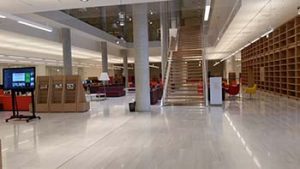 The library shelves were empty the day we visited but have recently been stocked with books. Its new location, the National Library of Greece, founded in 1832, includes an exclusive research facility and an all-inclusive public resource enter. The library supports patrons of all ages and education from academics to children and young adults.
The library shelves were empty the day we visited but have recently been stocked with books. Its new location, the National Library of Greece, founded in 1832, includes an exclusive research facility and an all-inclusive public resource enter. The library supports patrons of all ages and education from academics to children and young adults.
The entrance to the library’s new premises leads to a large open lobby. The public library section has a significant book collection as well as other media and includes separate areas for adults, teenagers and children offering a wide range of educational and cultural programs. The natural light creates a pleasant environment and the new design of the library meets the needs of the digital age. Research collections are housed in a central location with convenient access for researchers and scholars. Over 4,500 manuscripts from the 9th to the 19th century and a variety of important historical documents and archives are housed in the library. It will also function as a venue for exhibits, and a Business Center will provide the public with a resource for research, offering computer workstations, laptops and wireless connections. Events and seminars are hosted for both children and adults and classes will incorporate natural learning opportunities which will include programs outdoors at the Stavros Niarchos Park as well.
The roof of the library is actually part of a garden and on the upper patio there is a restaurant. From there you can enjoy the views of the picturesque surrounding area. The Center is built on an incline facing Athens, so to view the Bay of Faliron and the sea we took the elevator to the top of the opera house rather than walk up the hill to the small observation area.
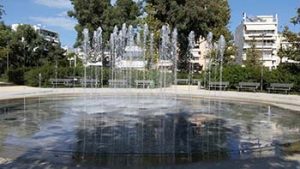 After visiting inside the Center we went out to explore the grounds and enjoy a picnic lunch under the shade of an olive tree. The park is a labyrinth of foot paths and roadways that lead past olive groves, orchards, plots of flowers as well as herb and vegetable gardens. A large green space playing field provides an area for sports or leisure. On the day we visited, groups of Syrian refugees and their children were playing on the grass and enjoying the cool spray of the fountains. There are bikes for rent, an outdoor theatre and lots of places for children to enjoy themselves while their parents relax in the shade.
After visiting inside the Center we went out to explore the grounds and enjoy a picnic lunch under the shade of an olive tree. The park is a labyrinth of foot paths and roadways that lead past olive groves, orchards, plots of flowers as well as herb and vegetable gardens. A large green space playing field provides an area for sports or leisure. On the day we visited, groups of Syrian refugees and their children were playing on the grass and enjoying the cool spray of the fountains. There are bikes for rent, an outdoor theatre and lots of places for children to enjoy themselves while their parents relax in the shade.
Except for opera tickets and bike rentals, everything is free at the Centre including tours and activities such as crafts, chess, computer instructions and gardening lessons.
We walked the length of the gardens to the back entrance of the park where we caught a bus back into the city. Our visit to the Stavros Niarchos Center was an interesting change from the busy cacophony of the city and a relaxing way to spend the afternoon.
If You Go:
Stavros Niarchos Cultural Center
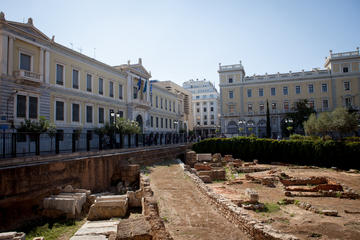
Private Tour: Ancient and Contemporary Athens Walking Tour
HOW TO GET THERE:
By Bus:
From Athens Center: Lines B2 550 pass through the metro station Sygrou. Get off at the Onasseio stop on Sygrou ave, head south in the direction of the sea up to Evripidou St.
From Kiffissia: Lines B2, 550. Get off at Eugenidio stop on Sygrou Ave northbound and pass through the underground pedestrian pass toward Kallithea.
From Pireaus: Lines A1, B1: get off at the Tzitzifies stop on Ethnarchou Makrariou Ave. walk down toward Glyfada the left onto Epaninontas st and right onto Peisistraotu St.
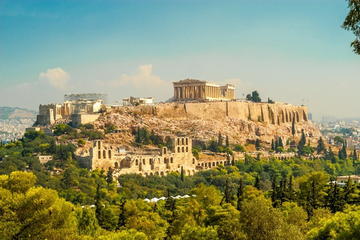
4-Night Athens Private Grand Tour
By Tram:
From downtown get off at Tzitzifies stop, walk toward Navarou Votsi St. and turn right at Peistitstratou and Sahtouri St for the entrance through parking lot.
By Trolley:
No. 10 from Halandri Sqaure to the Epaminonda stop. Walk towards Peisistratou and Sahtouris St to entrance through parking lot.
By Car:
You can drive to the Niarchos Centre. There are signs on Sygrou and Poseidonas Ave. and there is a large parking area.

Athens Half-Day Private Minivan Tour
About the author:
W. Ruth Kozak is an avid traveler to Greece and likes to explore new places each time she goes there. This visit to the Stavros Niarchos Cultural Centre was one of the highlights of a recent trip.
All photos by W. Ruth Kozak


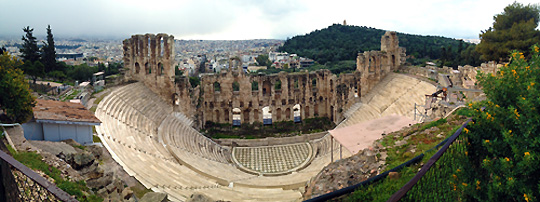
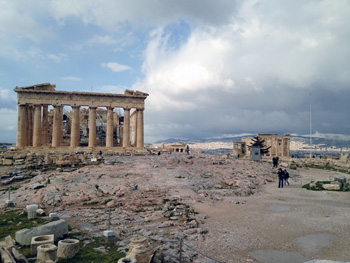 At this point, I wasn’t worried about the other passengers’ thoughts. Dignity, respect, pretending not to be a tourist – all out the window having tried very unsuccessfully to validate my 5 Euro ticket for a solid ten minutes of the bus ride. I could stare and gawp all I wanted; and so I did, drinking in that immense sight. I had read the myths since I was a kid, studied the history in school, and poured over the art for project after project in undergrad. Thrill raced through me faster than the cold had, as I discovered for the first time something I thought I already knew. Here it all was in 3D.
At this point, I wasn’t worried about the other passengers’ thoughts. Dignity, respect, pretending not to be a tourist – all out the window having tried very unsuccessfully to validate my 5 Euro ticket for a solid ten minutes of the bus ride. I could stare and gawp all I wanted; and so I did, drinking in that immense sight. I had read the myths since I was a kid, studied the history in school, and poured over the art for project after project in undergrad. Thrill raced through me faster than the cold had, as I discovered for the first time something I thought I already knew. Here it all was in 3D.
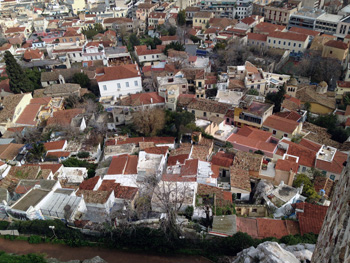 Thankfully, what he actually meant was that he couldn’t get me to the front door along the one-way pedestrian street. But he could get me close and, after a nice little chat about whether it was more expensive to live in the UK, he did. In hindsight, it was quite beneficial to have a little tour of the city. But on a pitch black evening in February, hindsight wasn’t on my mind. What I was actually thinking about was snow – snow in the Mediterranean. For the first time in five years, it was forecast to snow in Athens and as we drove, big white flakes melted on the windscreen. Not enough to stick in town, but there was plenty to pile up in the higher altitudes. From the Acropolis and the top of Lycabettus Hill, I spun circles the next day, looking round at the mountains that ringed the basin where the city lived. The big, slow flakes from last night had left them white-capped under cracks of blue sky between stacked layers of grey and white cloud. The sun, when it did decide to join the day, was cold and sharp and my ears froze. I had forgotten to pack a hat.
Thankfully, what he actually meant was that he couldn’t get me to the front door along the one-way pedestrian street. But he could get me close and, after a nice little chat about whether it was more expensive to live in the UK, he did. In hindsight, it was quite beneficial to have a little tour of the city. But on a pitch black evening in February, hindsight wasn’t on my mind. What I was actually thinking about was snow – snow in the Mediterranean. For the first time in five years, it was forecast to snow in Athens and as we drove, big white flakes melted on the windscreen. Not enough to stick in town, but there was plenty to pile up in the higher altitudes. From the Acropolis and the top of Lycabettus Hill, I spun circles the next day, looking round at the mountains that ringed the basin where the city lived. The big, slow flakes from last night had left them white-capped under cracks of blue sky between stacked layers of grey and white cloud. The sun, when it did decide to join the day, was cold and sharp and my ears froze. I had forgotten to pack a hat.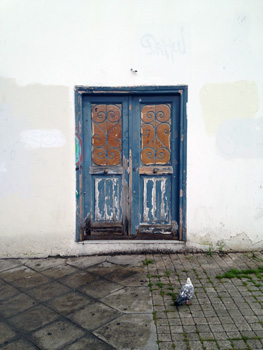 I found the lower gardens on the hill around the Acropolis full of temples and remains of buildings, statues, column capitals, and broken bits of foundations. The museums and Acropolis grounds felt more like walking into the pictures from the books I had read, studied, photocopied, and researched for the past six years. With an almost reverence, my eyes traced the draping folds of the stone garments that were so much softer and more alive than the drawings and photographs had shown me. Poseidon and Athena had to come to life and watched me carefully as I revelled in the neatly arranged Corinthian column caps I had modelled my own exhibition project on.
I found the lower gardens on the hill around the Acropolis full of temples and remains of buildings, statues, column capitals, and broken bits of foundations. The museums and Acropolis grounds felt more like walking into the pictures from the books I had read, studied, photocopied, and researched for the past six years. With an almost reverence, my eyes traced the draping folds of the stone garments that were so much softer and more alive than the drawings and photographs had shown me. Poseidon and Athena had to come to life and watched me carefully as I revelled in the neatly arranged Corinthian column caps I had modelled my own exhibition project on. After that, I walked and walked and walked the streets, looking for more awe-inspiring moments whatever the weather. Psirri turned out to be a fascinating district. I had booked myself into a lovely little hostel called City Circus for the week, where thankfully everything was warm and cozy with bountiful breakfast and friendly staff. Around the corner was a little spiders’ web of streets and five-point star intersections filled with shops and food. There were bars and music and fried filo dough and cheese concoctions in any shape I fancied. Lamp light and candle light poured through colored glass in the windows to join the colorful plaster walls. The music burst from inside the restaurants and the stones smacked hard under my new shoes. I didn’t want to stay long. I just wanted to see all of it, drink in this new, vivacious, loud place that breathed under my feet.
After that, I walked and walked and walked the streets, looking for more awe-inspiring moments whatever the weather. Psirri turned out to be a fascinating district. I had booked myself into a lovely little hostel called City Circus for the week, where thankfully everything was warm and cozy with bountiful breakfast and friendly staff. Around the corner was a little spiders’ web of streets and five-point star intersections filled with shops and food. There were bars and music and fried filo dough and cheese concoctions in any shape I fancied. Lamp light and candle light poured through colored glass in the windows to join the colorful plaster walls. The music burst from inside the restaurants and the stones smacked hard under my new shoes. I didn’t want to stay long. I just wanted to see all of it, drink in this new, vivacious, loud place that breathed under my feet. Athens’ graffiti was most unexpected. It was everywhere, unabashedly adorning abandoned houses, old government buildings, and ramshackle metal fences. My walk into town was a burst of color, screaming ideas at me that I could not understand. But still I knew they were trying to say something, trying to be heard amidst the throng of twelve-story concrete apartment complexes and canvas canopies. After a brisk souvenir search through the bustling side streets around Monastirkai Square, I grabbed a latte in a fourth-story coffee bar. It had huge windows looking out over the red tile roofs, all uneven height and helter-skelter pitch before stopping abruptly for the Hill to rise behind them. Buzzing with voices, the room was warm and curls of smoke caressed the windows. Out of the the top of the hill, the Acropolis rose overlooking the city, ever listening as the centuries marched past under its watchful gaze. How many stories had it seen unfold? What tales could it tell if only I could ask – what stories not found in any of my books? I would never know. My own stories would have to be enough for my curiosity.
Athens’ graffiti was most unexpected. It was everywhere, unabashedly adorning abandoned houses, old government buildings, and ramshackle metal fences. My walk into town was a burst of color, screaming ideas at me that I could not understand. But still I knew they were trying to say something, trying to be heard amidst the throng of twelve-story concrete apartment complexes and canvas canopies. After a brisk souvenir search through the bustling side streets around Monastirkai Square, I grabbed a latte in a fourth-story coffee bar. It had huge windows looking out over the red tile roofs, all uneven height and helter-skelter pitch before stopping abruptly for the Hill to rise behind them. Buzzing with voices, the room was warm and curls of smoke caressed the windows. Out of the the top of the hill, the Acropolis rose overlooking the city, ever listening as the centuries marched past under its watchful gaze. How many stories had it seen unfold? What tales could it tell if only I could ask – what stories not found in any of my books? I would never know. My own stories would have to be enough for my curiosity.
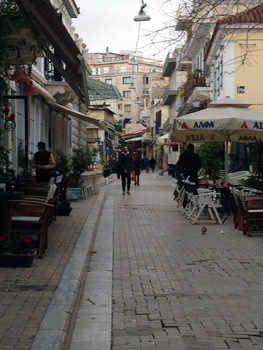 On the way back, we scootered through a seaside town and grabbed coffee. After the hustle of the city and the very present feeling of history at Aphaia, it was odd how quiet the coasts were. Big, abandoned holiday homes half-built lingered just off the shore, silent concrete skeletons that didn’t tell stories like the ancient ruins. I thought it was only the island, but as I sat in a restaurant on Athen’s shore, I was as the sole customer. It was full of chairs placed upside down on tables – a hundred inside and maybe more than a hundred outside. The place felt expectant but mournful, waiting for the summer visitors to come and fill it with vibrance. As I stared silently down the coast, I felt out of place for the first time on my trip. In walking in the footsteps of the ancient past, I had created my own stories. But each story I created was filled with the stories that had come before me. In walking the recently built-up coastline, I felt disconnected from the past, though it surely had no shortage of stories to tell. Perhaps I’m far too picky about architecture.
On the way back, we scootered through a seaside town and grabbed coffee. After the hustle of the city and the very present feeling of history at Aphaia, it was odd how quiet the coasts were. Big, abandoned holiday homes half-built lingered just off the shore, silent concrete skeletons that didn’t tell stories like the ancient ruins. I thought it was only the island, but as I sat in a restaurant on Athen’s shore, I was as the sole customer. It was full of chairs placed upside down on tables – a hundred inside and maybe more than a hundred outside. The place felt expectant but mournful, waiting for the summer visitors to come and fill it with vibrance. As I stared silently down the coast, I felt out of place for the first time on my trip. In walking in the footsteps of the ancient past, I had created my own stories. But each story I created was filled with the stories that had come before me. In walking the recently built-up coastline, I felt disconnected from the past, though it surely had no shortage of stories to tell. Perhaps I’m far too picky about architecture.